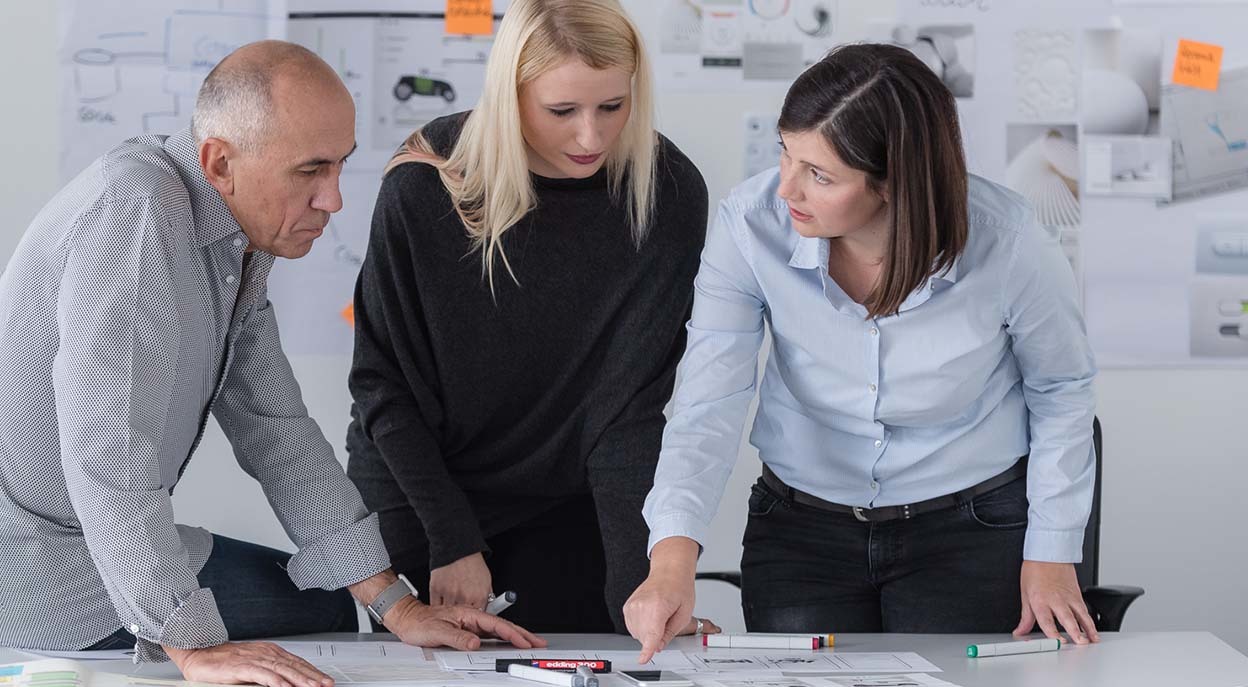21.01.2025
Shaping digital journeys with service design
Service design is a powerful approach to designing customer-centric services. In this article, we explain the differences to UX design as well as the challenges and benefits of service design for companies.
Technological innovations and new business models are reshaping markets and customer journeys are becoming increasingly complex – in this context, service design is becoming a key success factor for companies. While many may be familiar with the concept of user experience design (UX), service design goes beyond this and encompasses many more aspects that can have an impact, whether your customers perceive the company and its services positively or turn away. But what exactly is service design and why is it so important?

Service design vs. user experience design
Service design is an approach to designing holistic service systems that focuses on the needs of the user. The central idea of service design is to specifically involve the company’s internal organization in the design and to optimally align the entire company with the provision of services. It is not just about designing a great service, but also about realistically planning how this service can be successfully implemented with all the people involved. Technology and staff need to be well coordinated to create a positive customer experience. The people involved in the process must be able to contribute quickly and routinely and also react quickly and effectively in exceptional cases (which do not correspond to the “happy path”).
While user experience design (UX design) focuses primarily on the interaction of a user with a product or service, service design considers the entire process of service provision. Service design takes into account every single interaction, every little detail in the entire service process. Service design incorporates all internal processes, stakeholders and touchpoints to create consistent and seamless customer experiences. It considers not only the “what” of user interaction, but also the “how” and “why” of the entire service process. This approach is relevant across all industries – from healthcare to finance to public administration.
How are customer experience and service design connected?
Customer experience (CX) and service design are closely linked, as both are geared towards the goal of optimizing interactions between companies and their customers. CX describes the entirety of the experiences that customers have when interacting with a product, service or brand – from the initial contact through to long-term use.
In short, service design is the practical approach to shaping and continuously improving the customer experience by aligning processes, interactions and all touchpoints with customer needs and expectations

Challenges in service design
The holistic approach of service design brings with it some additional challenges in implementation.
You should know that:
- Complexity of coordination: bring your teams together! Service design requires coordination between various internal departments and external partners. Close collaboration is necessary to seamlessly connect all processes.
- Human factor: Really understand your target groups – their dreams, fears and desires! As service design involves many human interactions, it is important to fully understand the needs, expectations and emotions of users. The human factor applies in two respects. This is also a challenge on the company side. How can different employees react similarly and create the same experience?
- Continuous adaptation: become agile! Customer expectations are constantly changing. Companies need to be dynamic and flexible in order to react quickly to new trends and needs.
How service design drives companies forward
- Customer centricity: Customers should always be at the center of the design. Findings from customer research can provide valuable insights here. This increases customer loyalty and prevents dissatisfied customers from switching to competitors.
- Holistic approach: A comprehensive view of all touchpoints and processes is crucial for a seamless customer experience. This is how you create positive customer experiences. Because inconsistent or poorly designed services lead to frustration and dissatisfaction.
- Iterative process: Regularly testing and adapting services helps to keep them up-to-date and relevant. Continuous user feedback is the key to keeping your services in tune with the times.
- Strong product portfolio: Even the best product can fail if the associated service doesn’t work. Services with real added value for your customers strengthen your physical product and complement your portfolio perfectly.
Design your service with the right partner
When selecting a service design partner, it is important to consider the following criteria:

Comprehensive expertise in service design
An ideal partner should cover the entire service design process, from the research phase to creative concept development and user-centered implementation. This includes methods such as stakeholder mapping, shadowing and customer journey mapping, creative problem solving such as design thinking and futures thinking as well as tools for concept development and application design such as service blueprints, prototyping and UI/UX Design.
Strong digital expertise
A modern service provider should be able to integrate digital perspectives into service design. This includes the automation of processes, the design of effective self-service options and the ability to promote an engaging customer relationship across digital channels. Especially when this is the only channel between customer and provider.

Industry knowledge
A good service design partner knows your industry and is familiar with the specific requirements and challenges. This ensures that the solutions developed fit seamlessly into your business area.
Understanding of your product portfolio
The service provider should be able to take an in-depth look at your product portfolio in order to understand how service design can specifically increase customer benefits.
Efficient project management
As service design often brings together different disciplines, structured project management is essential. Make sure that your service provider is able to effectively facilitate workshops and coordinate interdisciplinary teams to develop a clear project roadmap.

From the field: Project examples for service design
Service optimization for discounter companies
We supported the optimization of a new business model in the online shopping sector through targeted customer interaction and analysis. To this end, we first conducted guerrilla surveys to gain valuable insights into the needs and expectations of potential users. Based on these findings, we developed and visualized different scenarios to illustrate improvement approaches. In addition, we organized focus groups to validate the ideas and hypotheses with (potential) customers. The results of the surveys and discussions flowed directly into the subsequent service optimization. Our focus here was on the aspects that are particularly relevant from the customer’s perspective in order to develop a customized and market-driven solution.
Optimization of an individual service in the pharmaceutical sector
The aim of the project was to optimize and expand an individual service so that it can be handled via a web portal. To this end, we conducted context interviews with customer employees in order to better understand the requirements of expert users. In the next step, we developed a typical workflow with up to ten roles as a service blueprint to structure the interactions. Based on this, the required screens per role were derived. In iterative workshops with expert users, we reviewed the screens to gather feedback and document content in content inventories. On this basis, the project team finalized the interaction concept and created the visual design, which was implemented in a minimum viable product.
The author
Dr. Jan Seifert works as Lead Experience Designer at UID. He has extensive experience in all phases of human-centered development. Depending on the project requirements, the qualified psychologist carries out the process himself, guides it or implements it. He specializes in the enterprise, industry and automotive sectors. He passes on his extensive knowledge and practical experience in talks and lectures. He is an active member of the User Research working group of the German UPA, the professional association of German usability professionals.

